Goopy Gyne Bagha Byne
A musical by Satyajit Ray
— written by Subhadrakalyan
(Reading Time: 27 min Approx)
The most iconic film director of India, Satyajit Ray, made an Indian fantasy adventure comedy film, Goopy Gyne Bagha Byne (The Adventures of Goopy and Bagha). The film was originally an adaptation of a twenty page short story, Goopy Gyne by Upendrakishore Roy Chowdhury, the grandfather of Satyajit Ray. Goopy and Bagha made their first appearance in the magazine, Sandesh, in 1915 with illustrations by the author. Goopy Gyne was a story to be reprinted from the early issues when Sandesh would be revived by Satyajit Ray in 1960. Ray started to make the film during 1967.
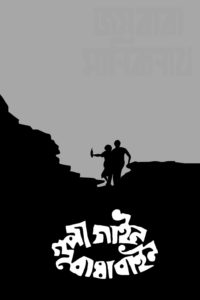
However, the movie was released much later on the 8th of May, 1969 starring Tapen Chatterjee as Goopy Gyne and Rabi Ghosh as Bagha Byne. The most important feature of the film is that Goopy Gyne sings and Bagha Byne plays the Dholak. There has been a magnificent exposition of brotherhood through the friendship of Goopy and Bagha, subsequently paralleled with the union of the two twin brothers, the two kings of two different countries. Ray has presented an immense expertise of him in both the spheres of films and music in the film, Goopy Gyne Bagha Byne (The Adventures of Goopy and Bagha).
Satyajit Ray made the film during the middle of his career. Having made fourteen long feature films, one short film and a documentary on Rabindranath Tagore before, he decided to make a film for the children, as his son Sandip Ray asked him to make a film for children. Apart from being just a children’s film, Goopy Gyne Bagha Byne propagates to the audience the eternal message on anti-war. Ray; through the basic storyline of the film where a king, on the instigation of his minister, declared war against another kingdom, ruled by his long lost brother and ultimately the two kings or the brothers reunite, Goopy and Bagha restraining the soldiers from suffering from the consequences of the war; has tried to emphasize on the notion, it is useless waging wars, for the kings who declare wars don’t suffer but the ones who fight the battles, the soldiers, and the commoners or the ones who live in the countries waging wars against one another, suffer the loses. Ray seems to be thoughtful about the similar incidents that took place after the two World Wars. Ray might also have referred to the Vietnam War of 1964 since the movie had been released shortly after the war in 1969.
Ray conceived the film as a musical for which he had written the songs much before he started to fair up the screenplay. The music score of the film was a one to revolutionize the face of music to be used in Indian films. In 1970, Angel published an LP record (AEX 4007) with the entire musical score of the film. As a sleeve note to the record, about the music of the film, Ray has himself said:
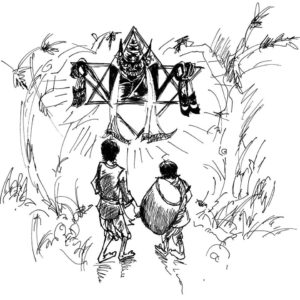
‘The film is freely adapted from the original, keeping the main lines of the plot, but adding new turns and twists, mainly to provide Goopy and Bagha with opportunities for singing and drumming. 4 out of the 7 songs sung by Goopy (with occasional vocal embellishments by Bagha) have more than a tinge of Bengali folk music in their rhythm and melody (Song Nos. 6 and 9 of Side I; 8 and 9 of Side II).Of the others, Nos. 5 of Side I is based on the classical morning raga Bhairavi. The accompaniment here consists of tanpura, two sitars, and a bamboo flute. Song No. 3 of Side II parodies the South Indian Carnatic style of singing, and uses, along with a trumpet and violins, the classical south Indian string instrument called the Veena.
‘Most of the orchestral pieces use a combination of eastern and western instruments: violin, cellos, electric guitar, trumpet, trombone, xylophone and vibraphone, as well as sitar, sarod, Indian flute and Indian percussion.
‘There are two items on this disc which were not composed by me. The first is the music of that goes with the Dance of the Ghosts. This is a straight reproduction of a form of percussion quartet popular in South India. The four instruments are the classical Mridanga, the popular Kanjira, the sharp sounding Ghattam which is nothing more than claypot, and the quaint, twangy Morsing, the tiny instrument which is held between the teeth and plucked with the forefinger. The other item is the beautiful flute melody on Side II. This I heard being played by a camel driver in Rajasthan: two flutes played simultaneously from the two corners of the mouth, one holding the drone and the other weaving the melody around it.’
The songs were sung by Anup Ghoshal, the then student of Rabindra Bharati University. He recalls, the rehearsals went on for twenty four days before the songs were finally taken for six consequent days at the India Film Laboratory. Apart from Ray himself, and Shyam Sundar Ghosh, the recordist, the other phenomenal personalities, forming the crew of the musicians, who were present on the floor were, Aloknath De, the conductor of the orchestra of Ray, Radhakanta Nandy, Aashish Khan, Kalyani Roy, Sujit Nath and Y.S. Mulki.

As far as the lyrics of the songs are concerned, it might be noticed that there is an astounding similarity between the moods of the lyrics and that of the tunes of the songs. Particularly for the songs, Ray had varied kinds of dialects with the traditional Bengali language. The mixture, of course a homogeneous one has a great ability to appeal to the minds of the audience, no matter how much traditionally non-grammatical the language might apparently seem. Ray had primarily focused on the easiness of the language rather than the norms of the application of the same. The ingenuity of the language strikes the audience to a large extent.
The musical treatment in the songs has a profound uniqueness. The tunes of the songs include the flavors of folk songs, Natyageet (the songs sung in a stage-play) and sometimes the tradition of Kathak (storytelling). Classicism too has its own way to be exposed through the songs, especially at the places where the usage of Indian Classical instruments has been noticed.
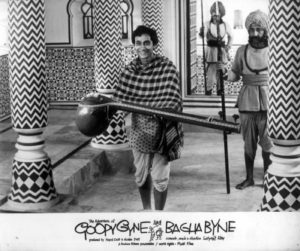
The entire music score of the film has an operatic effect on the audience. Right from the beginning of the movie the audience can observe the concept of music to be highly prominent. Even when Goopy’s song before he has been gifted with the boon is off the tune, the Tanpura he uses is perfectly tuned. The first song of the film, Dekho Re Nayan Mele has the brilliant application of the Indian raga Bhairavi can be observed with relevant sequences of ascending and descending orders of the tones of the scale. The emphasis on the lyrics has been justified with similar emphasis on the melody without deviating from the scale. The picturization of the song projects on the screen the time in the morning with a serene atmosphere much similar to the temperament of the composition of the song. Goopy having been granted with the boon to sing, rejoices his long cherished dream to have come true somersaulting and singing the song. It can be also interpreted this way: the ascension and descension in the tones within the scale exhibit the thrill flowing through the physique of Goopy.
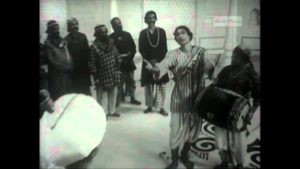
In the song, Maharaja Tomare Selam, the mood that has been depicted is just the opposite to the tranquil mood of the song mentioned previously. The feel of the folk is predominant in this song. The song applied in the sequence where Goopy and Bagha are expected to prove to the king of Shundi their superiority over the traditional practitioners of Indian Classical Music represents the ability of Goopy to surpass them through the sustenance of a tone for quite a long time. After a certain point, the rhythmic pattern of four followed by four in the song takes a vital turn when Goopy and Bagha seem to have gained even more confidence than before. The sudden upliftment of the tempo in the song, on the other hand, suggests the contentment of the entire court witnessing them perform. The song thus continues and eventually ends in a rhythmic pattern of six followed by six. From a different point of view, it can be inferred, Ray designed the entire sequence of different musicians coming to the court of Shundi to protest against the arrogance of the so called Hindustani Classical musicians, the ones who are often carried away by the apparent glamour of the art they practice and not go deep into the level of understanding it and who still believe in restricting and limiting the form of art as an individualistic approach and deny it its right to be exposed to the level to so as attain universality.
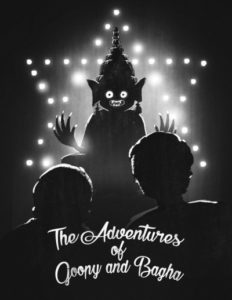
Goopy as a singer without being classically trained has been successful in propagating the sole message of peace through music. Once again the concept of universality is prominent in the lyrics of the song as he has stated through the song, he and Bagha only knew the language that didn’t involve verbal communications but was full of music, rhythm and fun and mirth and the king shall have got reminded of the dumb subjects of his country. One very intelligent action that has been undertaken by Ray is that he has used the voice of Girija Devi for a male actor as a singer in the court. The other classical numbers in Raag Todi and Raag Vrindavani Sarang were sung by Jaykrishna Sanyal. The song, Bhooter Raja Dilo Bor, involving a lot many variations even within the genre of folk music makes a stamp of its uniqueness. The unexpected pauses and the variation of the tempo assert the song as a typical Indian song. The charms of the physical movements of Goopy and Bagha have been readily warranted by the equally abrupt movements of the several rhythmic patterns applied in the song.
Ray had been quite particular in using the arresting tune for a song as O Mantrimashai. In this particular song, Ray had designed the soundscape in such a manner that it signifies the hypnotism and the spell that can be cast on people through the music of Goopy and Bagha. On the contrary, one can observe the school of operas or the troubadour school of music to be prominent in a song like Ek Je Chhilo Raja through which, Goopy as well as the director himself remarks, the possession of immense materialistic wealth drives a person crazy, and that he must dispose of his wealth to find peace and Bagha asserts the statements. The same can be again observed in the song, Bhooter Raja Dilo Bor, where the director accords to the school of operas by using the grave voice of Rabi Ghosh as Bagha; thus bringing in a great contrast in the aspect of music in the film; as in an opera all the participants sing. Ore Bagha Re, the song composed as a number resembling the Carnatic tradition of Indian music involves a great juxtaposition of Rudra Veena and Dholak being played together. In the concluding song of the film, Ore Baba Dekho Cheye, the usage of the Western instruments astounds the audience. The proper juxtaposition of the feel of folk and that of Western Classical Music and the astounding application of the Sarod in the interlude make the song to stand out among many other songs of Indian films. The message that the song carries is quite significant, since the song accords to the concept of anti-war. The lyrics of the song assure the audience of the fact, the soldiers, fighting the battle, and the common folk living in the countries waging war against each other suffer the fatal consequences of the wars fought. The entire belief that the movie intends to promote gets a rounded impressionistic interpretation through the song.
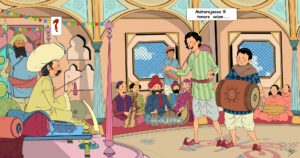
There has been a distinctive characteristic difference between the music pieces used during the projection of the court of Shundi and the same of that of Halla. The pitch remaining the same, it is a surprise for the audience to notice how the pattern changes from a major scale to a minor scale when the scene changes from the court of Shundi to the court of Halla.
From the point of view of music, the film has quite justifiable feature during the scene of the king of the ghosts granting the three boons to Goopy and Bagha. The king talks about the boons of unlimited food, dresses and the freedom to roam around the world in a mode of recitation but some melodies are added when the king talks about the boon of singing songs. This boon assures both Goopy Gyne and Bagha Byne would sing songs and play the Dholak respectively with equal ease. The discussion would remain incomplete, if it is not mentioned, the voice that we hear when the king of the ghosts speaks, is the technically distorted voice of Ray.
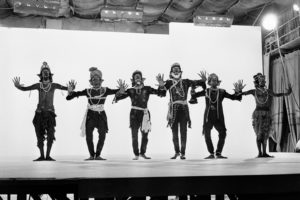
Ray has denied his credit for the composition that has been played along with the dance of the ghosts on the screen but musicians would be astounded to know his adeptness in choosing the right percussive instrument for the right scene to be shown on the screen during the sequence. Ray has projected series of different people in four broad classifications. The first type shows the people of an elevated class. Ray chose Mridangam for the instrument to be played in the background. Mridangam is itself an elevated instrument, probably the king of percussive instruments, in the southern India. The second type shows the underprivileged people and here, Ray decided to project the usage of Kanjira. As the third type comes on the screen comprising of the Englishmen, mostly the British rulers of India such as Hastings and Clive, Ghatam, another of a mainstream percussive instrument of the southern India finds a prominence. Lastly, when the fourth type appears comprising of some comic men, Ray comes down to using the Morsing in the background. His great understanding of music holistically as an art and not categorically as different genres finds a great precedence in this particular sequence.
The only song that Goopy doesn’t sing in the song is Achho Hetha Joto Ameer O Omrah. On the screen, Santosh Dutta, featured in the film as both the king of Shundi and the king of Halla, lip syncs the song sung by Kamu Mukherjee. The song has been presented as a declaration of war by the king of Halla against the king of Shundi. The roughness of the song offers the notion, that the king is violent and stupid.
Goopy Gyne Bagha Byne had been a musically successful movie. Ray had worked on the songs of Bengali films in two of his earlier movies, Devi and Chiriyakhana, each of them having a single song written and composed by Ray. His innate confidence on his creations of musical genius for these two movies has been reflected as he had once said, “They are my songs if you come to think of it. I have definitely set a style of singing which does not come from Tagore, does not come from Western music but which is essentially me.” After the tremendous success of Goopy Gyne Bagha Byne as a musical, Ray had said, again making his confidence on his creating musical milestones reflect in his statement, “It is extraordinary how quickly it has become part of popular culture. Really there isn’t a single child in the city who doesn’t know and sing the songs.”
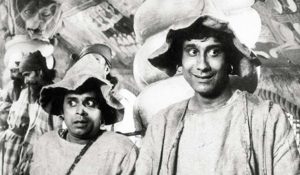
The music of the film Goopy Gyne Bagha Byne was really an appreciable one and all the stalwarts of Indian music, such as, Raichand Boral, Jnan Prakash Ghosh, Ravi Shankar, Nikhil Banerjee, Pankaj Kumar Mallik, Rajyeshwar Mitra, Hemanta Mukherjee, Nachiketa Ghosh, Debabrata Biswas and the likes admitted the music of the film was a genuinely unique creation by Ray. Fifty years have passed since the release of the film and still the film as well as the music of the film continues to enthrall the audience all across the world.
— by SUBHADRAKALYAN

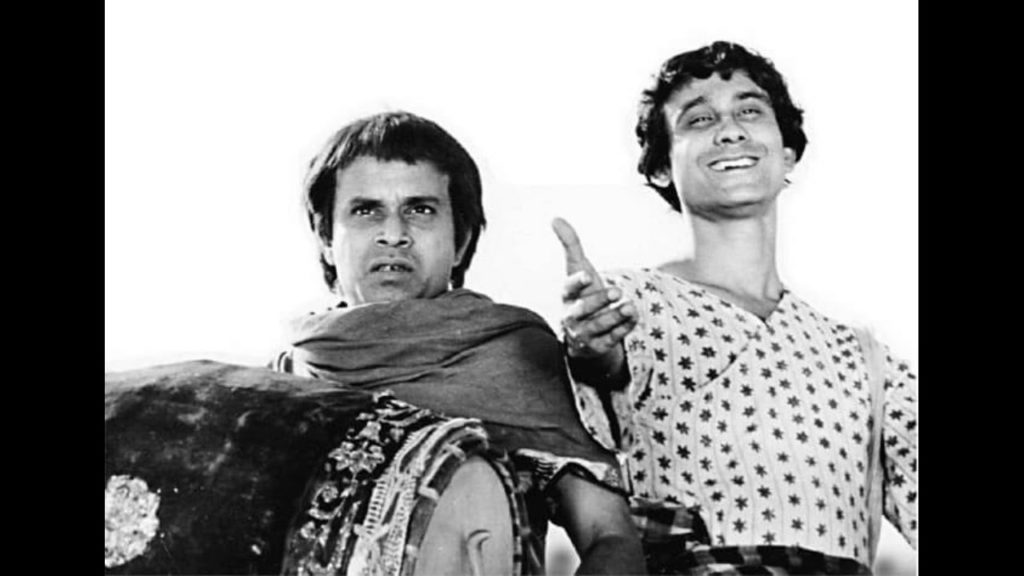
Khub sundor likhechs …❤️